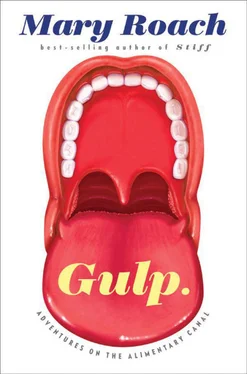John Harvey Kellogg was the archbishop of roughage. The healthy colon, he maintained, empties itself three or four times a day. This was “Nature’s Plan.” As evidence, he cited the estimable bowel frequency of “wild animals, wild men,… infants and idiots.” Kellogg’s sources included the staff at “well-managed idiot asylums” and ape keepers at the London Zoo. Kellogg paid several visits to the latter “for the express purpose” of discussing the toilet habits of their charges. The chimpanzees, noted Kellogg, “move their bowels four to six times daily.” All the more to throw at zoo visitors. Kellogg effected a habit of dressing in immaculate white suits, but probably not on the second and third visits.
Kellogg didn’t gather data on the regularity of “wild men,” but someone else sure did. In the early 1970s, epidemiologist A. R. P. Walker held a post at the South African Institute for Medical Research, affording easy access to Bantu people and others “pursuing a primitive manner of life.” In his travels through South African villages, Walker noted that “unformed stools are frequently encountered among rural Bantu.” One man’s ruined footwear is another’s eureka moment. The Bantu, Walker knew, were almost never diagnosed with Western digestive diseases. Was it because they ate so much fiber? Did their woody digesta exit the colon too quickly to inflict harm?
Walker got busy clocking stool: British versus Bantu. Subjects swallowed radio-opaque pellets and then “voided” into plastic bags that they labeled with the date and time. The bags were X-rayed [103] As an aside, Walker noted that “stools can be sieved to retrieve the pellets, thus avoiding the need for X-rays.” Who would sieve when they could X-ray? Someone who long ago wore out his welcome in the radiology department. Based on the following, I’m guessing Walker may also have been pushing his luck with Bantu villagers. “Eighty to 98 percent of rural Bantu children,” he marveled, can “produce a stool on request.”
so researchers could see exactly how long it took the pellets to complete their journey. As with foot races, so with digestion: the slowest third of the Bantu were quicker than the fastest third of the Caucasians. This was because, Walker assumed, the Bantu ate a shitload of insoluble fiber in the form of millet and corn porridge.
Walker was the man behind bran. Papers published by him and, more recently, his research partner Denis Burkitt, fueled a decade-long fiber craze. Americans were forcing down unprecedented amounts of bran muffins, oatmeal, and high-fiber breakfast cereals. Whorton cited a 1984 survey that found a third of Americans eating more fiber to stay healthy.
You don’t hear so much about fiber these days. Curious, I ran a PubMed search on cancer and dietary fiber. The most recent study, published in the American Journal of Epidemiology in 2010, followed three thousand Dutch men for thirteen years. Get a load: “Frequent bowel movements were associated with an increased risk of rectal cancer in men, and constipation was associated with a decreased risk.” Mike Jones wasn’t surprised. The medical community was never completely on board Burkitt’s fiber train. “He was comparing the Bantu to, like, British naval recruits, guys who ate practically no fiber and they all smoked.” Many other factors also set the British apart from rural black Africans—how do you control for them all? “It was correlation, not causality, and you really couldn’t take it any further.”
So why did we hear so much about fiber back then? Because, Jones said, there was money to be made: “things to go out and buy and eat more of.” Walker and Burkitt wrote the tune, but it was the cereal companies that kept on playing it. Jones said that when he sat down and looked at the studies on dietary factors and colon cancer, the thing that stood out as a determinant of risk wasn’t how much fiber you ate, but how many calories. The fewer calories, the lower the risk. No easy profits there.
AND GET THIS. The newest research suggests that slower transit time—that is, longer exposure to your nasty stuff, may in fact be of benefit. Hydrogen sulfide appears to prevent inflammation and its sometime consequences, ulcerative colitis and cancer. In rodent studies, anyway, the gas has a significant anti-inflammatory effect on the walls of the digestive tract: the opposite of what aspirin does in there. Aspirin and ibuprofen combat inflammation everywhere but the stomach and bowel; there they create inflammation. Used in tandem with hydrogen sulfide, says Ken Olson, a professor of physiology at Indiana University School of Medicine and author of multiple papers on the topic, aspirin or ibuprofen may be thousands of times as potent at preventing tumor growth—at least, in mice and in laboratory-grown tumor cells. Human trials have not yet begun.
Hydrogen sulfide is not the devil. Beneath the danger and stench is a molecule as basic and indispensable as sodium chloride. The gas is produced in all of the body’s tissues, all the time, regardless of what was for dinner. (Some recent thinking disagrees.) “It’s a gasotransmitter, a signaling molecule, it has tremendous therapeutic potential,” says Olson. “This is the hottest area in biomedicine right now.”
The moral of the story is this: It takes an ill-advised mix of ignorance, arrogance, and profit motive to dismiss the wisdom of the human body in favor of some random notion you’ve hatched or heard and branded as true. By wisdom I mean the collective improvements of millions of years of evolution. The mind objects strongly to shit, but the body has no idea what we’re on about.
HERE’S THE OTHER hitch with autointoxication. Absorbing things is primarily the business of the small intestine, not the colon. That’s what the smaller tube, with its millions of villi, is for: delivering nutrients to the blood. The autointoxication zealots would counter that, as John Harvey Kellogg put it, “the foul fecal matters in the colon pass back into the small intestine.” But, in fact, they don’t. The ileocecal valve, the anatomical portal between the small intestine and the colon, opens in one direction only.
It is possible to force open the ileocecal valve from the wrong direction, but it does not happen naturally, in the course of day-to-day living. It has tended to happen unnaturally, while dead, on a slab in a nineteenth-century anatomy amphitheater with one end of a flexible tube disappearing up the rectum and the other attached to a pump. No less than five experimenters, representing Britain, France, Germany, and the United States, from 1878 to 1885, tested the competence of the ileocecal valve. “Heschl made a number of experiments on the cadaver and satisfied himself that the ileocecal valve serves as a safe and perfect barrier against the entrance of fluids from below,” wrote the author of one review. W. W. Dawson of the Medical College of Ohio put the ileocecal through its paces on thirteen cadavers; in twelve, the valve held strong. The transcript of the thirteenth cadaver demonstration is printed in an 1885 issue of the Cincinnati Lancet and Clinic. (“From your seats,… you see the colon expanding as the fluid enters.”) This one, he concludes, was an anomaly. “The valve was doubtless imperfect.” But the showmanship flawless.
It seems fair to say that it takes an unnatural volume of liquid, under unnatural pressure, to breach the heroic ileocecal valve and enter the small intestine from the rear. It takes, perhaps, a Joy-Beauty-Life colonic irrigator. In their fervor to rid the body of fecal residues, devotees of internal bathing were flushing the dread residues higher up into the gut, away from the colon—a region of the anatomy that does relatively little absorbing—and right on into the one that evolved specifically for the job, the small intestine.
Читать дальше












